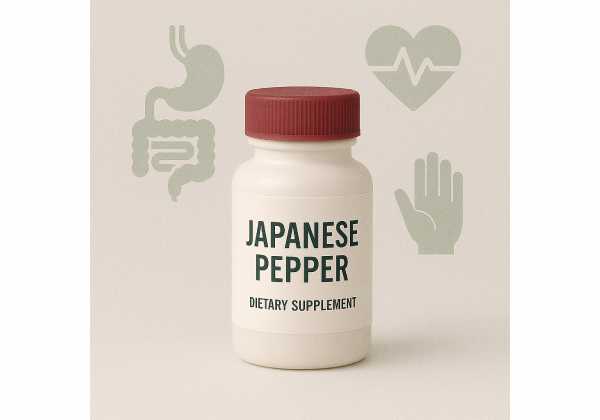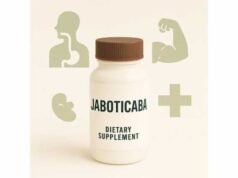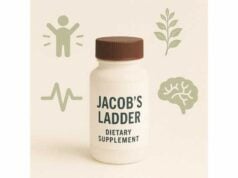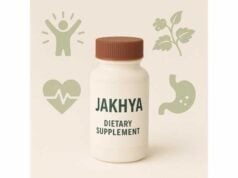
Japanese pepper (Zanthoxylum piperitum), also known as sansho or Japanese prickly ash, is a culinary spice and traditional herb valued for its bright citrus–pine aroma and a signature tingling sensation. That buzz is caused by alkylamides like hydroxy-alpha-sanshool, which interact with sensory nerve channels to create a lively, numbing feel on the tongue and skin. Beyond flavor, Japanese pepper contains volatile oils (such as limonene and linalool) and flavonoids that contribute antioxidant and digestive-soothing properties. Today you’ll find it in kitchen staples (like shichimi togarashi), topical creams and balms for a quick “awakening” feel, and modern nutraceuticals positioned for oral comfort or sensory relief. This guide cuts through folklore to explain what Japanese pepper can and cannot do, how to choose and use it (culinary, topical, and supplemental forms), realistic dosage ranges, preparation tips, safety considerations, and what the science actually supports—so you can enjoy the spice and its potential benefits with confidence.
Quick Overview
- Tingling alkylamides may support oral comfort and stimulate saliva, aiding mouthfeel and appetite.
- Essential oils and flavonoids offer antioxidant activity that may help with normal inflammatory balance.
- Typical culinary use: 0.2–2 g ground spice per serving; standardized extracts often 50–200 mg/day.
- May irritate sensitive skin or mucosa; avoid contact with eyes and broken skin.
- Avoid if pregnant, breastfeeding, or if you have known citrus/terpene sensitivities or active mouth ulcers.
Table of Contents
- What is Japanese pepper and how does it work?
- Evidence-backed benefits you can expect
- How to use it well: spice, teas, topicals, and extracts
- Dosage and timing: culinary and supplement ranges
- Safety, risks, and who should avoid it
- What the science says: a balanced summary
What is Japanese pepper and how does it work?
Japanese pepper (Zanthoxylum piperitum) is a small, aromatic member of the citrus family (Rutaceae). The spice comes from the dried pericarp (husk) of the fruit and the fresh young leaves (kinome) used in seasonal dishes. Its flavor is bright, lemony, and slightly piney. A hallmark feature is the pleasant tingling or buzzing sensation, distinct from the heat of chiles or the sharpness of black pepper. That sensation arises from plant alkylamides—chiefly hydroxy-alpha-sanshool—which target sensory nerve channels involved in temperature, touch, and pain signaling. In practical terms, a pinch can make food taste livelier by enhancing salivation and adding a clean “sparkle” to mouthfeel.
Mechanistically, sanshools interact with transient receptor potential (TRP) channels—especially TRPV1 and TRPA1—found on sensory neurons. These channels also respond to compounds in chili (capsaicin) and mustard/horseradish (allyl isothiocyanate), but sanshool’s profile is unique: it creates a tingling that feels like soft vibration rather than outright burning. Research also shows sanshool can modulate two-pore domain potassium channels (e.g., TASK), temporarily heightening touch sensitivity and contributing to the tingling–numbing paradox people notice when tasting sansho. This dual action helps explain why Japanese pepper excites the senses without overwhelming them.
Chemically, Japanese pepper contains volatile oils (limonene, linalool, geraniol, citronellal), coumarins, lignans, and flavonoids such as quercitrin and hyperoside. These compounds add aroma, antioxidant capacity, and—together with alkylamides—support the traditional uses for soothing a heavy palate, freshening the breath, and enlivening appetite. Kinome (the fresh leaf) leans more floral and citrusy, while the pericarp brings a stronger tingling kick. Quality varies with cultivar and post-harvest handling; fresher, well-stored spice retains more aroma and activity.
Culturally, Japanese pepper appears in spice blends (shichimi togarashi), noodle broths, grilled eel (unagi), and pickles. Outside the kitchen, modern formulators add standardized extracts to lozenges for sensory freshness and to topical balms or serums for a “wake-up” feel on skin. In short: Japanese pepper is both flavor and function—a culinary accent that also engages sensory biology in measurable ways.
Evidence-backed benefits you can expect
1) Sensory stimulation and oral comfort. The tingling from sanshool engages touch- and temperature-sensing nerve fibers. Many people experience this as mouth “brightness,” with a subtle increase in salivation and subjective freshness. For those who find rich or greasy meals dull the palate, a small sprinkle of ground pericarp before serving can bring back definition in flavors. In experimental settings, applying sanshool to skin or tongue transiently heightens detection of certain tactile frequencies, aligning with the everyday perception of a fine vibrating buzz. For culinary use, that translates to livelier mouthfeel without aggressive heat.
2) Digestive support via aroma and bitters. The essential oils and mild bitter notes in Japanese pepper can help stimulate the cephalic phase of digestion—saliva, gastric juice, and motility priming that begins with aroma and taste. While this is a general gastro-sensory effect rather than a targeted enzyme boost, many traditional cuisines intuitively use sansho near the end of cooking to nudge appetite and lighten heavy dishes (eel, fatty meats). Users often report less “coating” on the tongue and an easier transition between bites.
3) Antioxidant contribution. Flavonoids (e.g., quercitrin, hyperoside) and monoterpenes (limonene, linalool) contribute modest antioxidant capacity that supports normal oxidative balance. This is not a replacement for fruit- and vegetable-rich diets; rather, Japanese pepper can be a small, flavorful addition to an overall dietary pattern that favors plant diversity. When used regularly in spice-level amounts, it likely offers a gentle background contribution.
4) Topical “awakening” sensation. In skincare and wellness balms, low-dose Japanese pepper fruit extracts can create a rapid, noticeable toning feel. Some cosmetic research suggests improvements in the appearance of fine lines in formulations where Japanese pepper fruit extract is combined with peptides, though these are cosmetic endpoints (appearance, feel), not structural joint or musculoskeletal outcomes. For daily life, the practical benefit is sensorial: a quick, refreshing tingle that pairs with citrus–herbal aromatics.
What not to expect. Japanese pepper is not a fat-burner, painkiller, or cure for digestive disorders. Animal and in-vitro studies across the broader Zanthoxylum genus explore anti-inflammatory or metabolic effects, but human data for Japanese pepper alone remain limited and focused mainly on sensory mechanisms. Treat any dramatic claims with caution.
Who might appreciate it most. Home cooks seeking a vivid, non-spicy “spark,” people who enjoy citrus-herbal aromas, and those who like a tingling oral lozenge for short-term freshness. Topical users who enjoy fast sensory feedback may also appreciate low-dose products that include Z. piperitum fruit extract.
How to use it well: spice, teas, topicals, and extracts
Culinary spice (pericarp). Use freshly ground Japanese pepper at the end of cooking to preserve aromatics and tingling. Typical amounts range from a pinch (about 0.2–0.3 g) on a single serving of noodles or grilled fish up to 1–2 g for a family dish. Because sanshool’s sensation accumulates quickly, start small and build. Combine with salt and citrus zest to make a bright finishing sprinkle for vegetables or tofu. In shichimi togarashi, sansho partners with chili, sesame, and citrus peel—try it on rice bowls, soups, or roasted squash.
Kinome (young leaves). Use as a garnish: lightly bruise between fingers to release aroma, then add to miso soups, bamboo shoots, or spring vegetables. The leaf is more floral and less numbing than the pericarp. Avoid long simmering, which can mute the green top notes.
Teas and broths. For a light digestive infusion, steep 1–2 g crushed pericarp in hot water for 5–7 minutes, optionally with ginger or roasted barley tea. Strain well. This produces aroma and a mild tingle; do not expect the fuller culinary impact. If you’re caffeine-sensitive at night, this is an interesting herbal option.
Topicals. Look for formulations that disclose Zanthoxylum piperitum fruit extract, often paired with soothing bases (aloe, glycerin) or cosmetic peptides. Apply a small amount to intact skin only; a transient tingling sensation is expected. Avoid the eye area and open wounds. For first-time use, do a patch test on the inner forearm to ensure comfort.
Standardized oral extracts. Some nutraceuticals include Japanese pepper extract (alone or in blends) standardized to sanshool content. These products aim for sensory freshness and do not replace medical therapies. When labels specify standardization, it’s easier to keep intake consistent; if not, actual sanshool content can vary with harvest, processing, and storage. If you are already using other TRP-active botanicals (e.g., strong chili or wasabi supplements), coordinate timing to avoid stacking intense sensations.
Sourcing and storage. Buy whole pericarps and grind small amounts just before use for the brightest aroma. Store tightly sealed in a cool, dark place. Heat, light, and oxygen degrade both essential oils and alkylamides; replacing your jar each season keeps the flavor lively. For extracts and topicals, choose reputable brands that share identity testing and stability data.
Dosage and timing: culinary and supplement ranges
Culinary use (most common).
- Single-serve finishing: 0.2–0.5 g freshly ground pericarp sprinkled on food.
- Family dish: 1–2 g added off-heat, then adjusted to taste at the table.
- Infusion/tea: 1–2 g crushed pericarp in 250 ml hot water for 5–7 minutes; strain.
These amounts deliver noticeable aroma and tingling without overwhelming the palate. If you’re new to sansho, start at the low end and increase over a few meals. Discontinue or reduce if you notice mouth irritation.
Standardized extracts (oral).
- Common daily range: 50–200 mg/day of a standardized extract (providing an identified percentage of sanshool alkylamides), taken with food to minimize gastric discomfort.
- Blend products: If combined with other botanicals (e.g., citrus peel, ginger), follow the manufacturer’s serving size—often 1–2 capsules providing a total 100–300 mg of combined actives.
Because standardization varies, always read the label. If the product lists total extract without the active percentage, start lower (e.g., 50–100 mg/day) and gauge your personal sensitivity to tingling.
Topicals.
- Leave-on serums/creams: Often formulated at very low concentrations (e.g., fractions of a percent of fruit extract). Apply a pea-sized amount to intact skin once daily, and increase only if comfortable.
- Balms/gels for “wake-up” feel: Use sparingly on the temples, neck, or forearms; avoid mucous membranes.
Timing. Culinary use works best as a finishing spice. Extracts can be taken with breakfast or lunch; avoid close to bedtime if you are sensitive to sensory stimulants. Topicals are typically morning or pre-activity for the energizing feel.
Stacking with other botanicals. If you use strong TRP-active botanicals (chili, ginger, wasabi, black pepper extracts), space doses by a few hours to keep sensations pleasant and to monitor individual tolerance. For digestive infusions, pairing with ginger or roasted teas is common and generally well tolerated.
When to stop or reduce. If you notice persistent mouth soreness, reflux flare, or skin redness that lasts beyond 30–60 minutes after use, reduce dose or discontinue. Re-introduce at half the amount after a week if desired, and keep a simple log of intake versus sensations to find your personal sweet spot.
Safety, risks, and who should avoid it
General safety profile. As a culinary spice used in small amounts, Japanese pepper is well tolerated by most healthy adults. The most common reactions are transient tingling, mild oral numbness, or warmth at the site of contact—expected effects that usually fade within 10–30 minutes. In cosmetics, expert safety reviews conclude that low-dose Z. piperitum fruit extract and related ingredients are safe when formulated to be non-sensitizing and used as directed.
Potential irritants. Essential oil components (citronellal, geraniol, linalool) can irritate sensitive skin or mucosa. Avoid application to eyes, lips, or broken skin. If you have a history of contact dermatitis to fragranced products or citrus peels, patch-test first or choose fragrance-free alternatives.
Gastrointestinal sensitivity. Large amounts of pungent spices may aggravate reflux, active gastritis, or mouth ulcers. Culinary-level use is usually fine; concentrated extracts may be more noticeable. Take oral supplements with food and avoid during active flares.
Medication and condition considerations.
- Neuropathy or oral pain syndromes: Tingling agents may confuse symptom tracking. Introduce only under guidance and keep notes.
- Allergies: If you are allergic to members of the citrus family or to terpenes, avoid Japanese pepper.
- Pregnancy and breastfeeding: Safety data for concentrated extracts are insufficient. Culinary amounts are part of traditional diets, but it’s prudent to avoid supplemental doses during pregnancy or lactation unless your clinician specifically approves.
- Children: Use only as a culinary seasoning in small amounts. Avoid topical extracts on children’s skin unless a pediatric clinician agrees.
Quality and contamination. As with many botanicals, quality matters. Choose suppliers who test for identity, heavy metals, and pesticide residues. Essential oils and alkylamides oxidize with heat and light; stale product may be dull or irritating without the desired aroma.
What to do if you overdo it. If tingling becomes uncomfortable, rinse the mouth with milk or yogurt to help soothe; for skin, wash with mild soap and water and apply a bland moisturizer. Seek medical help for persistent swelling, hives, breathing difficulty, or eye exposure that does not resolve with irrigation.
Bottom line. Used sensibly, Japanese pepper is a flavorful, generally safe culinary and cosmetic ingredient. Respect the tingle, start low, and favor reputable products.
What the science says: a balanced summary
Strongest area: sensory neuroscience. Research on hydroxy-alpha-sanshool—the signature alkylamide in Japanese pepper—shows clear, reproducible effects on sensory neurons. It activates TRPV1 and TRPA1 channels and modulates two-pore domain potassium channels that shape touch perception. In human psychophysics, topical sanshool interferes with detection of certain vibration frequencies, matching the everyday experience of buzzing tingles on the tongue or skin. These findings are robust and explain why even tiny amounts of the spice feel vivid.
Moderate area: antioxidant contribution. Reviews of the Zanthoxylum genus report flavonoids and terpenes with antioxidant and anti-inflammatory activity in vitro and in animals. These data support a role for Japanese pepper as a minor contributor to dietary phytochemical intake, but they do not justify disease claims. Culinary-level consumption is reasonable for general wellness; concentrated extracts should be viewed as adjuncts, not therapies.
Emerging area: topical cosmetics. Low-dose fruit extracts in leave-on products can produce a fast sensory “tightening” feel. Small cosmetic trials suggest appearance benefits when paired with other actives, though endpoints are aesthetic rather than medical. Users should expect sensation, not structural change.
Gaps and limitations. High-quality human trials on digestive outcomes, metabolism, or pain relief are limited for Japanese pepper specifically. Standardization varies, making across-study comparisons difficult. Many broader Zanthoxylum studies involve different species with different phytochemical fingerprints; results may not transfer directly to Z. piperitum.
Practical takeaway. Enjoy Japanese pepper primarily for its culinary spark and sensorial freshness. If you explore supplements or topicals, choose standardized, well-tested products, start low, and use them for short-term sensory goals rather than disease management.
References
- Hydroxy-alpha-sanshool activates TRPV1 and TRPA1 in sensory neurons 2007 (Mechanism; TRP activation)
- Pungent agents from Szechuan peppers excite sensory neurons by inhibiting two-pore potassium channels 2008 (Mechanism; potassium channels)
- Sanshool on The Fingertip Interferes with Vibration Detection in a Rapidly-Adapting (RA) Tactile Channel 2016 (Human psychophysics)
- Zanthoxylum Species: A Comprehensive Review of Traditional Uses, Phytochemistry, Pharmacological and Nutraceutical Applications 2021 (Review; phytochemistry, activities)
- Safety Assessment of Zanthoxylum piperitum-Derived Ingredients as Used in Cosmetics 2023 (Safety; cosmetic use)
Disclaimer
The information in this article is educational and does not substitute for professional medical advice, diagnosis, or treatment. Always consult a qualified healthcare professional before starting any new supplement, topical regimen, or significant dietary change—especially if you are pregnant, breastfeeding, have ongoing medical conditions, or take prescription medications. If you experience irritation, stop use and seek medical guidance.
If you found this guide helpful, please consider sharing it on Facebook, X (formerly Twitter), or your favorite platform, and follow us for more evidence-based wellness content. Your support helps us continue creating high-quality resources.










